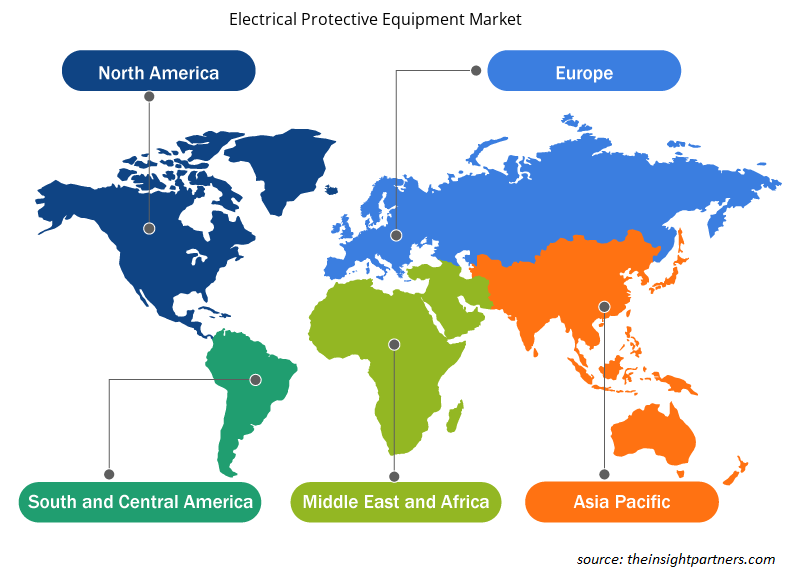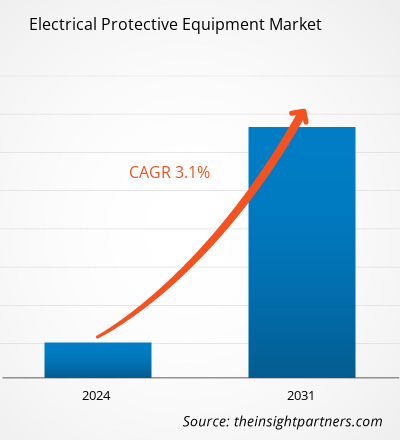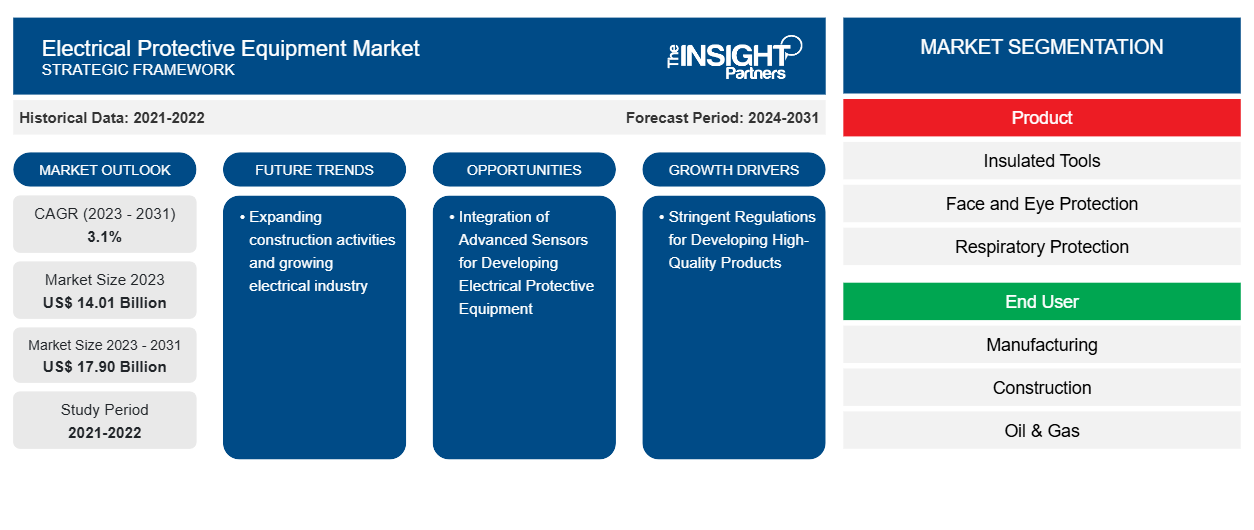Der Markt für elektrische Schutzausrüstungen soll von 14,01 Milliarden US-Dollar im Jahr 2023 auf 17,90 Milliarden US-Dollar im Jahr 2031 anwachsen. Der Markt wird voraussichtlich zwischen 2023 und 2031 eine durchschnittliche jährliche Wachstumsrate von 3,1 % verzeichnen. Ausweitende Bautätigkeiten und wachsende Projekte in der Elektroindustrie dürften weiterhin ein wichtiger Trend auf dem Markt für elektrische Schutzausrüstungen bleiben.CAGR of 3.1% in 2023–2031. Expanding construction activities and growing electrical industry projects are likely to remain a key electrical protective equipment market trend.
Marktanalyse für elektrische Schutzausrüstung
Der Markt für elektrische Schutzausrüstung wächst rasant, da strenge Vorschriften für die Entwicklung hochwertiger Produkte und die Expansion in den Bereichen Fertigung, Bauwesen, Öl und Gas, Gesundheitswesen, Transport und anderen Bereichen gelten. Der Markt wächst stetig, angetrieben durch das steigende Bewusstsein für die Sicherheitsvorteile, die elektrische Schutzausrüstung den Arbeitern bietet. Darüber hinaus bietet die Integration fortschrittlicher Sensoren zur Entwicklung elektrischer Schutzausrüstung lukrative Möglichkeiten für Marktwachstum.
Marktübersicht für elektrische Schutzausrüstung
Elektrische Schutzausrüstung ist Sicherheitsausrüstung, die zum Schutz von Arbeitern vor Lichtbögen, Stromschlägen und anderen Unfällen im Zusammenhang mit Elektrizität verwendet wird. Zu dieser Ausrüstung gehören isolierte Werkzeuge, Gesichts- und Augenschutz, Atemschutz, Schutzkleidung, Kopfschutz und andere Ausrüstung, die von Arbeitern in gefährlichen Branchen wie Bergbau, Öl und Gas, Stromerzeugung , Fertigung und anderen verwendet wird. Darüber hinaus schafft die Integration fortschrittlicher Sensoren zur Entwicklung elektrischer Schutzausrüstung im Prognosezeitraum Möglichkeiten für elektrische Schutzausrüstung.
Passen Sie diesen Bericht Ihren Anforderungen an
Sie erhalten kostenlos individuelle Anpassungen an jedem Bericht, einschließlich Teilen dieses Berichts oder einer Analyse auf Länderebene, eines Excel-Datenpakets sowie tolle Angebote und Rabatte für Start-ups und Universitäten.
- Holen Sie sich die wichtigsten Markttrends aus diesem Bericht.Dieses KOSTENLOSE Beispiel umfasst eine Datenanalyse von Markttrends bis hin zu Schätzungen und Prognosen.
Treiber und Chancen auf dem Markt für elektrische Schutzausrüstung
Strenge Vorschriften für die Entwicklung hochwertiger Produkte treiben den Markt an
Strenge Regeln und Vorschriften der Regierung für die Herstellung hochwertiger elektrischer Schutzausrüstung treiben den Markt an. Beispielsweise regelt der Standards Council of Canada die kanadische PSA streng nach dem Canadian Electric Code (CDC) und stellt sicher, dass elektrische Produkte die geltenden Sicherheitsstandards erfüllen und ein Höchstmaß an Arbeitssicherheit bieten. Gemäß dem Ontario Electrical Safety Code, wie in der Ontario-Verordnung 777/21 dargelegt, hat die kanadische Regierung Hersteller und Lieferanten verpflichtet, das ESA-Zertifizierungszeichen für ihre Produkte zu erwerben und das erforderliche Genehmigungsverfahren zu durchlaufen. Strenge Zertifizierungsregeln, die eine hohe Produktqualität fördern, fördern also das Wachstum des Marktes für elektrische Schutzausrüstung.PPE under the Canadian Electric Code (CDC), ensuring that electrical goods meet applicable safety standards and provide the highest level of worker safety. According to the Ontario Electrical Safety Code, as outlined in Ontario Regulation 777/21, the government of Canada mandated manufacturers and suppliers to obtain the ESA certification mark for their products and follow the required approval process. Thus, stringent certification rules that promote high product quality are boosting electrical protective equipment market growth.
Integration fortschrittlicher Sensoren zur Entwicklung elektrischer Schutzausrüstung – eine Chance auf dem Markt für elektrische Schutzausrüstung
Elektrische Schutzausrüstung wird durch die Integration moderner Sensoren immer fortschrittlicher. Handschuhe sind beispielsweise mit Sensoren ausgestattet, um die Spannungspegel zu überwachen und Arbeiter vor möglichen Gefahren zu warnen. In Lichtbogenschutzanzügen angebrachte Wärmesensoren können automatische Kühlvorrichtungen aktivieren, um Überhitzung zu verhindern. Daher wird erwartet, dass schnelle technologische Fortschritte im Prognosezeitraum Innovationen auf dem Markt für elektrische Schutzausrüstung vorantreiben werden. Darüber hinaus erfreut sich intelligente persönliche Schutzausrüstung bei den Benutzern aufgrund der zunehmenden Nutzung von Daten und Technologie zur Verbesserung der Arbeitssicherheit und des Situationsbewusstseins immer größerer Beliebtheit. Dies verringert das Risiko und kann die Reaktionszeiten der Arbeiter in Notfällen verbessern.
Segmentierungsanalyse des Marktberichts für elektrische Schutzausrüstung
Wichtige Segmente, die zur Ableitung der Marktanalyse für elektrische Schutzausrüstung beigetragen haben, sind Produkt und Endbenutzer.
- Basierend auf dem Produkt ist der Markt für elektrische Schutzausrüstung in isolierte Werkzeuge, Gesichts- und Augenschutz, Atemschutz, Schutzkleidung, Kopfschutz und andere unterteilt . Das Segment Gesichts- und Augenschutz hatte im Jahr 2023 einen größeren Marktanteil.
- Auf der Grundlage des Endverbrauchers ist der Markt in Fertigung, Bauwesen, Öl und Gas, Gesundheitswesen, Transport und andere segmentiert. Das Fertigungssegment hielt im Jahr 2023 den größten Marktanteil.
Marktanteilsanalyse für elektrische Schutzausrüstung nach geografischer Lage
Der geografische Umfang des Marktberichts für elektrische Schutzausrüstung ist hauptsächlich in fünf Regionen unterteilt: Nordamerika, Asien-Pazifik, Europa, Naher Osten und Afrika sowie Südamerika/Süd- und Mittelamerika.
In Bezug auf den Umsatz hatte Nordamerika den größten Marktanteil im Bereich elektrischer Schutzausrüstung, da in der Öl- und Gasindustrie viele Risiken bestehen. Die Branche ist zahlreichen Risiken ausgesetzt, wie Explosionen, Lichtbögen und Stromschlägen durch Niederspannungsmotoren, Mittelspannungsgeräte und Verteilertafeln, was die Nachfrage der Arbeiter nach elektrischer Schutzausrüstung zum Schutz erhöht. Darüber hinaus schaffen wachsende Stromübertragungsleitungen und die expandierende Stromerzeugungsindustrie in naher Zukunft erhebliche Wachstumschancen auf dem Markt.
Regionale Einblicke in den Markt für elektrische Schutzausrüstung
Die regionalen Trends und Faktoren, die den Markt für elektrische Schutzausrüstung während des gesamten Prognosezeitraums beeinflussen, wurden von den Analysten von Insight Partners ausführlich erläutert. In diesem Abschnitt werden auch die Marktsegmente und die Geografie für elektrische Schutzausrüstung in Nordamerika, Europa, im asiatisch-pazifischen Raum, im Nahen Osten und Afrika sowie in Süd- und Mittelamerika erörtert.

- Erhalten Sie regionale Daten zum Markt für elektrische Schutzausrüstung
Umfang des Marktberichts über elektrische Schutzausrüstung
| Berichtsattribut | Details |
|---|---|
| Marktgröße im Jahr 2023 | 14,01 Milliarden US-Dollar |
| Marktgröße bis 2031 | 17,90 Milliarden US-Dollar |
| Globale CAGR (2023 - 2031) | 3,1 % |
| Historische Daten | 2021-2022 |
| Prognosezeitraum | 2024–2031 |
| Abgedeckte Segmente | Nach Produkt
|
| Abgedeckte Regionen und Länder | Nordamerika
|
| Marktführer und wichtige Unternehmensprofile |
|
Dichte der Marktteilnehmer für elektrische Schutzausrüstung: Die Auswirkungen auf die Geschäftsdynamik verstehen
Der Markt für elektrische Schutzausrüstung wächst rasant, angetrieben durch die steigende Nachfrage der Endnutzer aufgrund von Faktoren wie sich entwickelnden Verbraucherpräferenzen, technologischen Fortschritten und einem größeren Bewusstsein für die Vorteile des Produkts. Mit steigender Nachfrage erweitern Unternehmen ihr Angebot, entwickeln Innovationen, um die Bedürfnisse der Verbraucher zu erfüllen, und nutzen neue Trends, was das Marktwachstum weiter ankurbelt.
Die Marktteilnehmerdichte bezieht sich auf die Verteilung der Firmen oder Unternehmen, die in einem bestimmten Markt oder einer bestimmten Branche tätig sind. Sie gibt an, wie viele Wettbewerber (Marktteilnehmer) in einem bestimmten Marktraum im Verhältnis zu seiner Größe oder seinem gesamten Marktwert präsent sind.
Die wichtigsten auf dem Markt für elektrische Schutzausrüstung tätigen Unternehmen sind:
- 3M
- ALPHA PRO TECH, LTD
- Ansell Limited
- Cintas Corporation
- Delta Plus-Gruppe
- Honeywell International Inc.
Haftungsausschluss : Die oben aufgeführten Unternehmen sind nicht in einer bestimmten Reihenfolge aufgeführt.

- Überblick über die wichtigsten Akteure auf dem Markt für elektrische Schutzausrüstung
Neuigkeiten und aktuelle Entwicklungen zum Markt für elektrische Schutzausrüstung
Der Markt für elektrische Schutzausrüstung wird durch die Erhebung qualitativer und quantitativer Daten nach Primär- und Sekundärforschung bewertet, die wichtige Unternehmensveröffentlichungen, Verbandsdaten und Datenbanken umfasst. Im Folgenden finden Sie eine Liste der Entwicklungen auf dem Markt für elektrische Schutzausrüstung und Strategien:
- Safe Arc Solutions Limited plant, die Ausgabe 2024 ihres Standards der National Fire Prevention Association (NFPA) im Mai 2024 zu veröffentlichen. Die NFPA enthält einen Standard für elektrische Sicherheit am Arbeitsplatz, bekannt als NFPA 70E. (Quelle: Safe Arc Solutions Limited, Pressemitteilung, 2022)
Marktbericht zu elektrischen Schutzausrüstungen – Umfang und Ergebnisse
Der Bericht „Marktgröße und Prognose für elektrische Schutzausrüstung (2021–2031)“ bietet eine detaillierte Analyse des Marktes, die die folgenden Bereiche abdeckt:
- Marktgröße und Prognose auf globaler, regionaler und Länderebene für alle wichtigen Marktsegmente, die im Rahmen des Projekts abgedeckt sind
- Marktdynamik wie Treiber, Beschränkungen und wichtige Chancen
- Wichtige Zukunftstrends
- Detaillierte PEST/Porters Five Forces- und SWOT-Analyse
- Globale und regionale Marktanalyse mit wichtigen Markttrends, wichtigen Akteuren, Vorschriften und aktuellen Marktentwicklungen
- Branchenlandschaft und Wettbewerbsanalyse, einschließlich Marktkonzentration, Heatmap-Analyse, prominenten Akteuren und aktuellen Entwicklungen
- Detaillierte Firmenprofile
- Historische Analyse (2 Jahre), Basisjahr, Prognose (7 Jahre) mit CAGR
- PEST- und SWOT-Analyse
- Marktgröße Wert/Volumen – Global, Regional, Land
- Branchen- und Wettbewerbslandschaft
- Excel-Datensatz
Aktuelle Berichte
Erfahrungsberichte
Grund zum Kauf
- Fundierte Entscheidungsfindung
- Marktdynamik verstehen
- Wettbewerbsanalyse
- Kundeneinblicke
- Marktprognosen
- Risikominimierung
- Strategische Planung
- Investitionsbegründung
- Identifizierung neuer Märkte
- Verbesserung von Marketingstrategien
- Steigerung der Betriebseffizienz
- Anpassung an regulatorische Trends





















 Kostenlose Probe anfordern für - Markt für elektrische Schutzausrüstung
Kostenlose Probe anfordern für - Markt für elektrische Schutzausrüstung